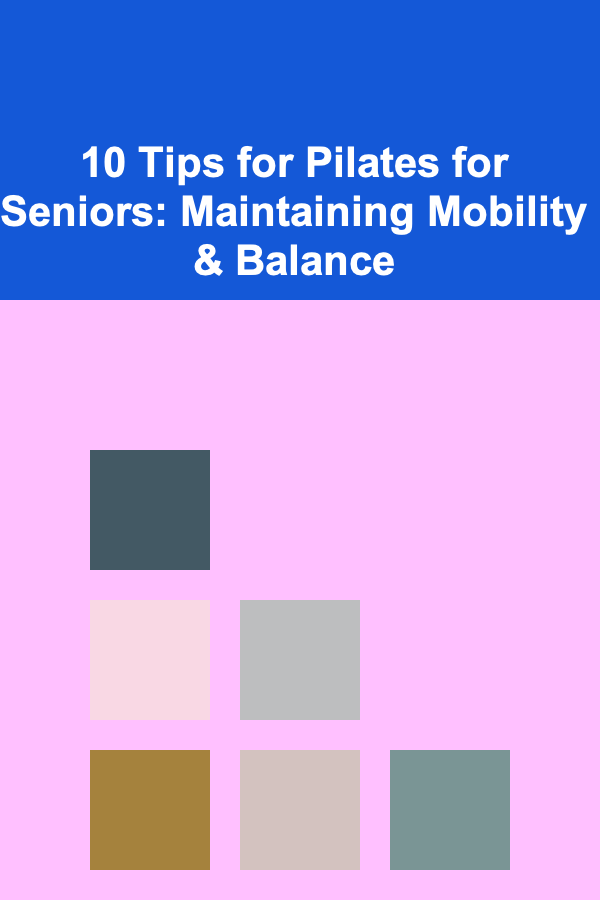
10 Tips for Pilates for Seniors: Maintaining Mobility & Balance
ebook include PDF & Audio bundle (Micro Guide)
$12.99$10.99
Limited Time Offer! Order within the next:

As we age, maintaining mobility and balance becomes increasingly important for preserving independence and preventing falls. One highly effective form of exercise that helps seniors achieve these goals is Pilates. Pilates focuses on strengthening the core, improving flexibility, and enhancing posture, all of which contribute to better balance, stability, and mobility. Additionally, Pilates is low-impact, making it ideal for seniors who may have joint concerns or other physical limitations.
In this article, we'll explore 10 practical tips for seniors looking to incorporate Pilates into their routines to enhance mobility, balance, and overall well-being. These tips are designed to be accessible, with modifications to ensure safety and effectiveness for older adults.
Start with a Consultation
Before beginning any new exercise program, it's important to consult with a healthcare provider, especially if you have any pre-existing medical conditions or concerns. Pilates can be beneficial for people with arthritis, osteoporosis, or chronic back pain, but it's important to tailor the exercises to your specific needs.
Your doctor may also be able to recommend specific exercises that are suitable for your current health status and advise you on any precautions to take. Additionally, if you have access to a Pilates instructor with experience in teaching seniors, they can offer personalized modifications and help ensure proper form and technique.
Focus on Core Strength
One of the key benefits of Pilates is its emphasis on core strength. The core muscles, which include the abdominals, lower back, and pelvic floor muscles, are vital for maintaining balance and preventing falls. By engaging these muscles during Pilates exercises, seniors can build a stronger foundation for stability.
Core exercises to try:
- Pelvic Tilts: Begin by lying on your back with your knees bent and feet flat on the floor. Slowly tilt your pelvis upward, engaging your abdominal muscles. This movement helps strengthen the lower back and abdominal muscles.
- Bridges: Lie on your back with knees bent and feet flat on the floor, then lift your hips off the mat by engaging your glutes and abdominal muscles. This exercise targets the core and lower body, promoting strength and stability.
- Seated Tummy Twists: Sit tall on the floor with your legs extended in front of you, or modify the position by sitting on a chair. Hold your hands together and twist your torso to one side, engaging the core muscles. This movement improves flexibility and strengthens the obliques.
These core exercises not only help improve balance but also contribute to better posture and spinal alignment, which are crucial for preventing falls.
Embrace Breathing Techniques
Pilates places a strong emphasis on breathing, and learning how to breathe properly can make a significant difference in how you feel during and after your workout. Breathing deeply helps oxygenate your muscles, supports relaxation, and promotes better movement patterns.
In Pilates, the typical breathing pattern involves inhaling through the nose and exhaling through the mouth while engaging the core. This controlled breathing helps connect the body and mind, improving focus and movement efficiency.
To practice Pilates breathing:
- Place one hand on your ribcage and the other on your abdomen.
- Inhale deeply through your nose, allowing your ribs to expand outward.
- Exhale fully through your mouth, drawing the ribs back in toward your spine.
- Continue this breathing pattern throughout your Pilates session, focusing on deep, controlled breaths.
By incorporating this mindful breathing into your Pilates practice, you will not only improve oxygen flow to your muscles but also enhance your body's ability to engage the correct muscles during each movement.
Modify Exercises for Comfort and Safety
As you begin Pilates, it's important to remember that modifications are perfectly acceptable, especially when starting out or if you have specific limitations. Many Pilates exercises can be adjusted to accommodate different levels of flexibility, strength, and mobility.
For example, if you're not able to perform an exercise on the floor, you can modify it by using a chair or other props. Similarly, if you have difficulty with balance, use a wall or a sturdy chair to support you as you practice certain movements.
Modifications for common Pilates exercises:
- Leg Circles: If lying on your back is uncomfortable, try performing this exercise seated in a chair. Simply extend one leg at a time and perform small circles while keeping your core engaged.
- Rolling Like a Ball: If rolling on the mat causes discomfort, you can modify this by holding onto a chair while performing a gentle rocking motion with the upper body to engage the core.
- Side-Lying Leg Lifts: Perform this exercise standing near a wall for support instead of lying down. This allows you to work the same muscles while maintaining better balance and stability.
With modifications, Pilates can be accessible and beneficial for seniors of all fitness levels. The key is to listen to your body and make adjustments as needed to ensure comfort and safety.
Work on Flexibility and Range of Motion
Maintaining flexibility is crucial as we age, as it helps prevent stiffness, improve mobility, and reduce the risk of injury. Pilates is an excellent way to improve flexibility, as many exercises focus on lengthening muscles and improving joint mobility.
Flexibility exercises to try:
- Cat-Cow Stretch: Start on all fours with your hands under your shoulders and knees under your hips. As you inhale, arch your back and look up (Cow pose), then as you exhale, round your back and tuck your chin toward your chest (Cat pose). This movement helps improve flexibility in the spine and stretches the back and neck muscles.
- Standing Side Stretches: Stand tall with your feet shoulder-width apart. Raise one arm overhead and gently lean to the opposite side to stretch the side of the body. Hold for a few breaths, then switch sides.
- Seated Forward Fold: Sit on the floor with your legs extended in front of you. Inhale to lengthen your spine, then exhale and gently fold forward, reaching toward your toes. This stretches the hamstrings and lower back, promoting flexibility in the lower body.
By incorporating flexibility exercises into your Pilates routine, you can maintain a full range of motion in your joints, which is key to maintaining independence as you age.
Focus on Posture
Posture plays a vital role in balance and stability. Poor posture can lead to back pain, stiffness, and an increased risk of falls. Pilates exercises encourage proper alignment, helping seniors improve their posture and maintain a more upright and balanced stance.
Posture-improving Pilates exercises:
- Chest Opener: Sit tall on a chair with your feet flat on the ground. Interlace your fingers behind your head and gently pull your elbows back, opening up the chest. This exercise helps counteract the effects of slouching and improves upper back posture.
- Seated Spine Stretch: Sit with your legs extended in front of you. Inhale to lengthen the spine, then exhale as you gently reach forward, keeping your back straight. This movement helps strengthen the muscles along the spine and encourages better posture.
- Wall Roll-Downs: Stand with your back against a wall, feet a few inches away. Slowly roll your spine down, one vertebra at a time, keeping your core engaged. This exercise promotes spinal mobility and helps with alignment.
Improving posture through Pilates will not only make you feel more confident but also reduce the strain on your muscles and joints, leading to better overall mobility.
Integrate Balance Training
Balance is one of the most important factors in preventing falls, and Pilates is excellent for improving both static and dynamic balance. Many Pilates exercises challenge your balance by incorporating single-leg movements, unstable surfaces, and coordination.
Balance exercises to try:
- Single-Leg Stands: Stand tall and slowly raise one leg off the ground, holding the position for a few seconds. To increase the challenge, try closing your eyes or standing on a soft surface like a yoga mat.
- Standing Heel-to-Toe Walks: Walk in a straight line, placing the heel of one foot directly in front of the toes of the other. This helps improve balance and coordination.
- Bird Dog: Start on all fours with your hands under your shoulders and knees under your hips. Extend one arm forward and the opposite leg backward, holding the position for a few seconds. This exercise strengthens the core and improves balance.
Balance training through Pilates not only helps seniors stay steady on their feet but also improves coordination, which is vital for daily activities such as walking and climbing stairs.
Use Props to Enhance Exercises
Props can be a helpful addition to a Pilates routine, especially for seniors. Using props such as resistance bands, Pilates rings, or small balls can provide additional support, increase the intensity of exercises, and make certain movements more accessible.
Common props for Pilates:
- Resistance Bands: These bands can be used to add resistance to movements, making exercises like leg lifts or arm presses more challenging and effective.
- Pilates Ring: A small, flexible ring that can be used to engage specific muscle groups in exercises like leg presses, arm circles, or thigh squeezes. It can also be used to assist in certain stretches.
- Small Ball: A soft ball can be placed between the knees or under the lower back to encourage better posture and activate deeper core muscles.
Props allow you to modify Pilates exercises to suit your body's needs and help you gradually increase strength and flexibility without straining.
Progress Gradually
It's important to take a gradual approach to Pilates as you build strength, flexibility, and balance. Start with basic exercises and work your way up to more complex movements as your body adapts.
As you progress, focus on maintaining proper form and breathing, and listen to your body. If you feel any discomfort or strain, stop and consult with an instructor or healthcare provider for adjustments. Progressing at your own pace will help prevent injury and ensure a sustainable Pilates practice.
Stay Consistent
Finally, consistency is key when it comes to Pilates for seniors. Aim to practice Pilates regularly---whether it's two to three times a week or more, depending on your fitness level and goals. Even small, consistent sessions can have a profound impact on your mobility, balance, and overall health.
Consider joining a group Pilates class for seniors or working with a certified Pilates instructor to ensure you're performing exercises correctly and safely. Many community centers or fitness clubs offer specialized classes for older adults, providing a supportive environment and a sense of camaraderie.
Pilates is a wonderful way for seniors to improve mobility, balance, and overall health. By following these 10 tips, you can safely and effectively incorporate Pilates into your routine, leading to greater strength, flexibility, and confidence. Whether you're looking to prevent falls, alleviate discomfort, or simply stay active, Pilates offers a versatile and enjoyable way to support your health and well-being as you age.
Reading More From Our Other Websites
- [Home Family Activity 101] How to Make Mouthwatering Homemade Ice Cream: Recipes and Tips
- [Personal Care Tips 101] How to Use Sunscreen to Maintain Even Skin Tone Year-Round
- [Home Party Planning 101] How to Decorate a Small Space for a Home Party
- [Organization Tip 101] How to Use a Rolling Cart for Portable Beauty Storage
- [Home Soundproofing 101] How to Soundproof Your Home During Construction
- [Home Staging 101] How to Stage a Small Living Room: Maximizing Functionality and Style
- [Personal Investment 101] Monetizing AI: How to Earn Money by Creating Deep Learning Applications
- [Home Pet Care 101] How to Keep Your Pet's Skin and Coat Healthy at Home
- [Home Holiday Decoration 101] How to Design a Winter-Themed Living Room for Cozy Gatherings
- [Home Pet Care 101] How to Get Your Pet Microchipped: A Simple Guide to Permanent Identification

How to Maximize Small Closet Space for Better Organization
Read More
How to Sell Collectible Vinyl Records on Online Marketplaces: A Comprehensive Guide
Read More
How to Soundproof Your Walls Using DIY Methods
Read More
How To Explore DNA Barcoding for Species Identification
Read More
Renovating with Feng Shui in Mind: Planning for Positive Change
Read More
How to Research Before Visiting Historical Landmarks
Read MoreOther Products

How to Maximize Small Closet Space for Better Organization
Read More
How to Sell Collectible Vinyl Records on Online Marketplaces: A Comprehensive Guide
Read More
How to Soundproof Your Walls Using DIY Methods
Read More
How To Explore DNA Barcoding for Species Identification
Read More
Renovating with Feng Shui in Mind: Planning for Positive Change
Read More